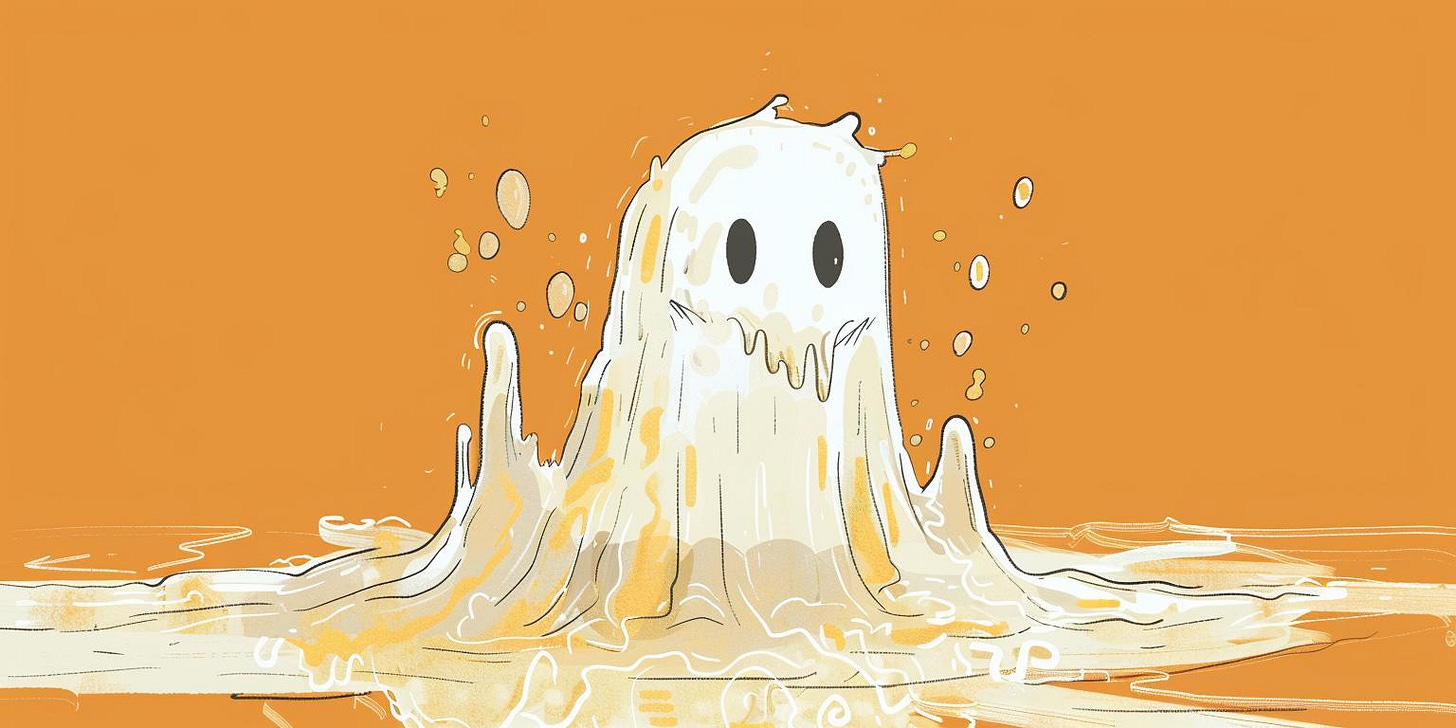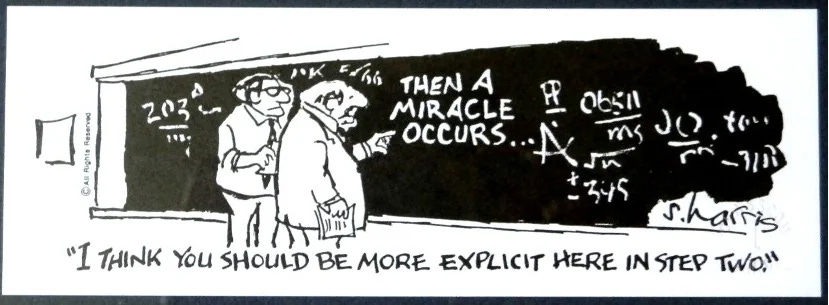Substance Dualism and the Interaction Problem
The Five Most Controversial Ideas in the Study of Consciousness [Part 2]
Hello Curious Humans!
Last week I had dinner with my nephew. He’s 8. All boys his age, I am told, will not stop talking about Ghostbusters. My nephew is no exception. We played Ghostbusters. I was the ghost. I got slimed. And all was right with the world.
Until it wasn’t.
It was entirely my fault, of course. I’m sure it had something to do with me asking the wrong question. Or maybe I was being too sciencey. Again. Aunty Suzi!
But we’ll get to that later.
This week in When Life Gives You AI, we’re continuing our series on The Five Most Controversial Ideas in the Study of Consciousness with Part 2: Substance Dualism and the Interaction Problem.
Substance Dualism is the theory of consciousness proposed by René Descartes, who is most famous for the statement, I think, therefore, I am.
This week we’re asking:
What is Substance Dualism?
Why does Substance Dualism have an interaction problem? and
How can we avoid the interaction problem?
But first.
How to pronounce Descartes?
Descartes is pronounced DAY-KART. Descartes was French, so we pronounce D-e-s as “Day”, and the final "s" is silent.
Okay. French lesson is over; let’s dive in!
1. What is Substance Dualism?
Descartes’s most famous work, Meditations on First Philosophy, was first published in 1641.
During this time, philosophers were grappling with one of the big classic philosophical questions — how can we know anything for certain? Many philosophers reasoned that because what we often accept as true is a product of custom and culture, which varies from one culture to the next — knowledge, or truth, is relative. That is, knowledge depends on one’s viewpoint. This is a radical position to take — if knowledge is relative, then certainty is not possible. But this was the prevailing idea at the time.
Descartes was sceptical of this prevailing view. His work in the Meditations focused on finding an answer to one main related question: Is there anything that we can know for sure — without any doubts?
In the first meditation, he notes all the things he believes to be true. He goes through each belief and asks — can I be 100% sure this is true? But he quickly confronts the possibility that an evil demon might be deceiving him about the nature of everything. And, at the end of the first mediation, he ends up at the same conclusion as many philosophers of his time — he doubts the truth of all his beliefs.
But early in the Second Meditation, Descartes arrives at a crucial insight: he cannot doubt his own doubting. This realisation leads him to conclude that, even if an evil demon is deceiving him, the very act of doubting confirms his existence—because doubting is a form of thinking, and one cannot think if one does not exist. So, he discovers one thing he can know for sure: I am. I exist.
Following his realisation, Descartes makes an important claim — a claim that has had an enormous impact on our modern conception of the mind. He asserts that the "I" in "I am. I exist" is a thinking thing that does not have a physical form.
This represents a significant shift in thought. Prior to Descartes, it was common among philosophers to view the mind (or soul) as inseparable from the body. But Descartes makes a distinction between sensation — the feeling of what it is like — and the physical processes. By differentiating sensation from the physical, Descartes laid the groundwork for substance dualism, the idea that our world is made of two distinct substances — physical substances (matter) and non-physical substances (minds). An idea that dominates much of the philosophical discussions about consciousness to this day.
2. Why does Substance Dualism have an interaction problem?
The concept of non-physical things poses an interesting conundrum. We can’t see non-physical things. We can’t measure them; they don’t take up space; they have no physical properties at all — that’s what non-physical means. Non-physical things are not really things at all. Not in the way we would want them to be if we wanted to study them, like scientists. Indeed, many would argue there are no such things as non-physical things.
My nephew tells me ghosts are non-physical things. They don’t have a body. I am told. They do what non-physical things do, apparently. They go through walls just before you’re about to zap them with your Particle Thrower (a Particle Thrower, I am told, is the blaster attached to a Proton Pack). These non-physical ghosts are hard to catch. I’m not a very good ghost. I am told. So, I am quickly abandoned for the more elusive type of ghosts — the ones throwing plates at our heads and dodging beams of protons being shot from the Particle Thrower.
It was at that moment, amid the imaginary plate throwing, that I made my big mistake. It wasn’t my finest moment. I am embarrassed to admit it. I asked the wrong — very wrong — question.
How can a ghost both be able to go through walls and pick up plates? Why doesn’t the ghost’s hand just go through the plate?
Yes, I know! What type of Aunty do I think I am? Too Sciencey — indeed.
In The Passions of the Soul, Descartes argues that the mind is a ghostly soul that is tethered to the body at the pineal gland in the brain. He chose the pineal gland because he noticed that information comes into the brain in twos — we have two eyes, two ears, and two hands. He reasoned that if information comes into the brain in twos, it must join together somewhere in the brain. The only place in the brain that he could find where this might happen was the pineal gland. All other brain parts came in twos — but the pineal gland — there’s only one of those. So, the ghostly soul must join the body there.
A thought like "I am thirsty," for example, being a non-physical part of the mind, would move the animal spirits, which would, in turn, make small movements in the pineal gland, which had large effects on the body — prompting the sensation of thirst and the subsequent physical action of reaching for a glass of water.
When Descartes was writing about his ideas about dualism, he had a pen pal — Princess Elizabeth of Bohemia. The two would often exchange letters about Descartes's ideas. Princess Elizabeth raises a problem with Descartes's theory in one of those letters. In my words, she asked the following:
How do non-physical thoughts move anything? It seems to me that for something to be moved, it needs to move itself, or it needs to be pushed or pulled by something that is physical. But you have claimed that the mind is non-physical — it takes up no space. How can a non-physical thing that takes up no space have any effects on the physical world at all?
This is the interaction problem. And it’s a big problem. Although Descartes's idea of the mind as separate from the body is currently one of the more popular theories of consciousness, no one has found a scientifically satisfactory way to solve the interaction problem. To solve the interaction problem, we would need to find a mechanism that goes beyond the current laws of physics. There is no empirical evidence of such a mechanism.
When it comes to consciousness, sometimes it feels like there is a point at which we need to take a leap of faith — where logical consistency and scientific facts can only take us so far. For some, substance dualism is the point where they leap.
But for many, Descartes's solution to the interaction problem is not a satisfactory explanation.
3. How can we avoid the interaction problem?
If we don’t want to leap at substance dualism, we have two main ways to avoid it. We can reject the interaction, or we can reject the dualism.
Rejecting the interaction
We could keep the idea that the mind and brain are separate substances but reject the idea that they interact. Two notable theories under this umbrella are:
Parallelism, which suggests that the mind and brain are in harmony but don’t interact causally.
Epiphenomenalism proposes that the brain influences (or emerges from) the mind, but the mind has no influence on the brain. It’s a one-way relationship.
Rejecting the dualism
Alternatively, we could reject the idea that the mind and brain are separate substances. We could do this in a few different ways:
We could argue for a form of property dualism, where the mind is not a separate substance but a set of properties that emerge from (or are inherent to) the brain. This perspective retains a dualistic view of mind and matter but doesn’t claim that the mind is a separate substance.
Alternatively, we move to some form of monism, which means we reject the dualistic separation altogether — there’s just one substance. This could lead to either physicalism, where everything is ultimately physical, or a more radical stance that everything is non-physical.
The Sum Up
The biggest challenge for substance dualism is the interaction problem.
And the biggest challenge for playing Ghostbusters is not questioning the physics of ghostly plate handling.
Thanks for being here. In Part 3 of our series on the Five Most Controversial Ideas in the Study of Consciousness, we’ll explore solipsism — the idea that only my mind exists.






It’s never too early to get enthusiastic about philosophy! Long ago (>10y), I very much enjoyed “The Philosopher At The End Of The Universe” by Mark Rowlands, which was based on his generosity in mapping some aspects of popular cinema onto philosophy in a fin way. I’d like to think it helped me talk on ethics - but nowadays it’s a well supported method of introducing students into the realms of philosophical thought. Ghostbusters works well here. I’m enjoying your pieces very much. Thank you.
Thanks for yet another engaging deep dive, Suzi.
I enjoyed your personal ghost anecdotes throughout the piece.
The kids' brains (minds? head-ghost-entities? intangible-animal-spirits?) work in curious ways.
The other day my son Nathan (8) asked what a "hypothesis" was. My wife explained it patiently, at which point he said: "But what if it's low?" (In his mind, it was "high-pothesis.")
Now if you'll excuse me, I have to go and contend with the duality of both "Day-Cart" and "Dess-Car-Tess" existing simultaneously in my head.